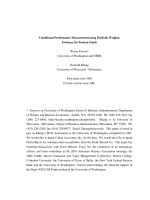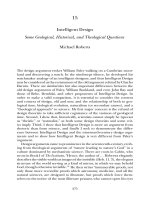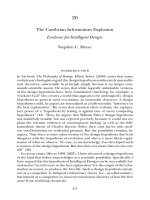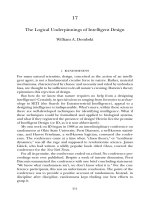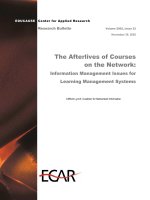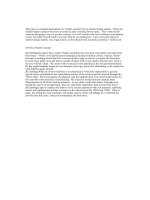The Cambrian Information - Explosion Evidence for Intelligent Design
Bạn đang xem bản rút gọn của tài liệu. Xem và tải ngay bản đầy đủ của tài liệu tại đây (115.92 KB, 22 trang )
P1: KAF/IRK P2: JZP
0521829496c20.xml CY335B/Dembski 0 521 82949 6 April 2, 2004 21:17
20
The Cambrian Information Explosion
Evidence for Intelligent Design
Stephen C. Meyer
introduction
In his book The Philosophy of Biology, Elliott Sober (2000) notes that many
evolutionary biologists regard the design hypothesis as inherently untestable
and, therefore, unscientific in principle simply because it no longer com-
mands scientific assent. He notes that while logically unbeatable versions
of the design hypothesis have been formulated (involving, for example, a
“trickster God” who creates a world that appears to be undesigned), design
hypotheses in general need not assume an untestable character. A design
hypothesis could, he argues, be formulated as a fully scientific “inference to
the best explanation.” He notes that scientists often evaluate the explana-
tory power of a “hypothesis by testing it against one or more competing
hypotheses” (44). Thus, he argues that William Paley’s design hypothesis
was manifestly testable but was rejected precisely because it could not ex-
plain the relevant evidence of contemporary biology as well as the fully
naturalistic theory of Charles Darwin. Sober then casts his lot with mod-
ern neo-Darwinism on evidential grounds. But the possibility remains, he
argues, “that there is some other version of the design hypothesis that both
disagrees with the hypothesis of evolution and also is a more likely expla-
nation of what we observe. No one, to my knowledge, has developed such
a version of the design hypothesis. But this does not mean that no one ever
will” (46).
In recent essays (Meyer 1998, 2003), I have advanced a design hypothesis
of the kind that Sober acknowledges as a scientific possibility. Specifically, I
have argued that the hypothesis of Intelligent Design can be successfully for-
mulated as “an inference to the best explanation” for the origin of the infor-
mation necessary to produce the first life. Such a design hypothesis stands,
not as a competitor to biological evolutionary theory (i.e., neo-Darwinism),
but instead as a competitor to chemical evolutionary theories of how life first
arose from nonliving chemicals.
371
P1: KAF/IRK P2: JZP
0521829496c20.xml CY335B/Dembski 0 521 82949 6 April 2, 2004 21:17
372
Stephen C. Meyer
In order to make this argument, I show that considerations of causal ad-
equacy (Hodge 1977, 239; Lipton 1991, 32–88) typically determine which
among a group of competing explanations qualify as best. I then argue against
the causal adequacy of each of the main categories of naturalistic explana-
tion – chance, necessity, and their combination – for the origin of biological
information. Further, in order to avoid formulating a purely negative “argu-
ment from ignorance,” I also argue for the positive adequacy of intelligent
agency as a cause of information. I note, in the words of the information
theorist Henry Quastler, that the “creation of new information is habitually
associated with conscious activity” (1964, 16). Thus, I conclude that Intelli-
gent Design stands as the best – most causally adequate – explanation for
the origin of the information necessary to produce the first life.
In this volume, Professors Dembski and Bradley amplify the two com-
plementary aspects of this argument – Dembski, by suggesting that living
systems possess a reliable positive indicator of the activity of an intelligent
cause, namely, “complex specified information”; Bradley, by challenging the
causal adequacy of naturalistic explanations for the origin of the informa-
tion necessary to the first life. Jointly, these two chapters provide both a
negative case against the adequacy of naturalistic theories and a positive
case for the causal adequacy of Intelligent Design, thereby supporting Intel-
ligent Design as the best explanation for the information necessary to the
first life.
thesis
This chapter extends this line of reasoning by formulating another, more
radical design hypothesis. Rather than positing Intelligent Design solely as
an explanation for the origin of the information necessary to the first life,
this chapter will offer Intelligent (or purposive) Design as an explanation
for the information necessary to produce the novel animal body plans that
arise during the history of life. This design hypothesis thus competes directly
with neo-Darwinism in two respects. First, it seeks to explain the origin of
the novel biological form (and the information necessary to produce it)
that emerges after the origin of the first life. Second, it posits the action of a
purposive intelligence, not just a purposeless or undirected process, in the
history of life.
Many scientists now openly acknowledge the fundamental difficulties fac-
ing chemical evolutionary theories of the origin of life, including the prob-
lem of explaining the origin of biological information from nonliving chem-
istry. Nevertheless, many assume that theories of biological evolution do not
suffer from a similar information problem. While many scientists recognize
that invoking natural selection at the pre-biotic level remains theoretically
problematic (since natural selection presumably acts only on self-replicating
organisms), neo-Darwinists assume that natural selection acting on random
P1: KAF/IRK P2: JZP
0521829496c20.xml CY335B/Dembski 0 521 82949 6 April 2, 2004 21:17
The Cambrian Information Explosion
373
mutations within already living organisms can generate the information
needed to produce fundamentally new organisms from preexisting forms.
I will dispute this claim. I will argue that explaining the origin of novel bio-
logical information is not a problem confined to origin-of-life research, but
rather one that afflicts specifically biological theories of evolution as well.
In order to this make this case, I will examine a paradigm example
of a discrete increase in biological information during the history of life:
the Cambrian explosion. I will then compare the explanatory power of
three competing models – neo-Darwinism, self-organization, and Intelligent
Design – with respect to the origin of the information that arises during the
Cambrian.
the cambrian explosion
The “Cambrian explosion” refers to the geologically sudden appearance of
many new animal body plans about 530 million years ago. At this time, at least
nineteen and perhaps as many as thirty-five phyla (of forty total phyla) made
their first appearance on Earth within a narrow five-million-year window of
geologic time (Meyer et al. 2003; Bowring et al. 1993). Phyla constitute the
highest categories in the animal kingdom, with each phylum exhibiting a
unique architecture, blueprint, or structural body plan. Familiar examples
of basic animal body plans are mollusks (squids and shellfish), arthropods
(crustaceans, insects, and trilobites), and chordates, the phylum to which
all vertebrates belong.
An especially dramatic feature of the Cambrian explosion was the first
appearance of invertebrate phyla with mineralized exoskeletons, including
members of the phyla Mollusca, Echinodermata, and Arthropoda. Many well-
preserved animals with soft tissues also first appeared, including represen-
tatives of Ctenophora, Annelida, Onycophora, Phoronida, and Priapulida. Fossil
discoveries from the Lower Cambrian Yuanshan Formation in China have
also shown the presence of animals from the phylum Chordata, including
two fish fossils, Myllokunmingia fengjiaoa and Haikouichthys ercaicunensis, sug-
gesting an earlier appearance for vertebrates than previously thought (Shu
et al. 1999).
To say that the fauna of the Cambrian period appeared in a geologically
sudden manner also implies the absence of clear transitional intermediate
forms connecting Cambrian animals with simpler pre-Cambrian forms. And
indeed, in almost all cases, the Cambrian animals have no clear morpholog-
ical antecedents. Debate now exists about the extent to which this pattern of
evidence can be reconciled with the theory of universal common descent.
This essay will not address that question but will instead analyze whether the
neo-Darwinian mechanism of natural selection acting on random mutations
can generate the information necessary to produce the animals that arise
in the Cambrian.
P1: KAF/IRK P2: JZP
0521829496c20.xml CY335B/Dembski 0 521 82949 6 April 2, 2004 21:17
374
Stephen C. Meyer
defining biological information
Before proceeding, I must define the term “information” as used in biol-
ogy. In classical Shannon information theory, the amount of information
in a system is inversely related to the probability of the arrangement of
constituents in a system or the characters along a communication channel
(Shannon 1948). The more improbable (or complex) the arrangement,
the more Shannon information, or information-carrying capacity, a string
or system possesses.
Since the 1960s, mathematical biologists have realized that Shannon’s
theory could be applied to the analysis of DNA and proteins to measure
their information-carrying capacity. Since DNA contains the assembly in-
structions for building proteins, the information-processing system in the
cell represents a kind of communication channel (Yockey 1992, 110). Fur-
ther, DNA conveys information via specifically arranged sequences of four
different chemicals – called nucleotide bases – that function as alphabetic
or digital characters in a linear array. Since each of the four bases has a
roughly equiprobable chance of occurring at each site along the spine of
the DNA molecule, biologists can calculate the probability, and thus the
information-carrying capacity, of any particular sequence n bases long.
The ease with which information theory applies to molecular biology has
created confusion about the type of information that DNA and proteins
possess. Sequences of nucleotide bases in DNA, or amino acids in a protein,
are highly improbable and thus have a large information-carrying capac-
ity. But, like meaningful sentences or lines of computer code, genes and
proteins are also specified with respect to function. Just as the meaning of a
sentence depends upon the specific arrangement of the letters in the sen-
tence, so too does the function of a gene sequence depend upon the specific
arrangement of the nucleotide bases in the gene. Thus, as Sarkar points out,
molecular biologists beginning with Francis Crick have equated information
not only with complexity but also with “specificity,” where “specificity” or
“specified” has meant “necessary to function” (1996, 191).
Similarly, this chapter poses a question, not about the origin of Shannon
information – mere complexity of arrangement – but about the origin of
the “specified complexity” or “complex specified information” (CSI) that
characterizes living systems and their biomolecular components.
the cambrian information explosion
The Cambrian explosion represents a remarkable jump in the specified com-
plexity or CSI of the biological world. For over three billion years, the bio-
logical realm included little more than bacteria and algae. Then, beginning
about 570 mya, the first complex multicellular organisms appeared in the
rock strata, including sponges, cnidarians, and the peculiar Ediacaran biota.
Forty million years later, the Cambrian explosion occurred. The emergence
P1: KAF/IRK P2: JZP
0521829496c20.xml CY335B/Dembski 0 521 82949 6 April 2, 2004 21:17
The Cambrian Information Explosion
375
of the Ediacaran biota (570 mya), and then to a much greater extent the
Cambrian explosion (530 mya), represented steep climbs up the biological
complexity gradient.
One way to measure the increase in CSI that appears with the Cambrian
animals is to assess the number of new cell types that emerge (Valentine
1995, 91–3). Studies of modern animals suggest that the sponges that ap-
peared in the late Precambrian, for example, would have required five cell
types, whereas the more complex animals that appeared in the Cambrian
(such as representatives of Arthropoda) would have required fifty or more
cell types. Functionally more complex animals require more cell types to
perform their more diverse functions. New cell types require many new and
specialized proteins. New proteins, in turn, require new genetic information.
Thus an increase in the number of cell types implies (at minimum) a consid-
erable increase in the amount of specified genetic information. Molecular
biologists have recently estimated that a minimally complex single-celled
organism would require between 318 and 562 kilobase pairs of DNA to pro-
duce the proteins necessary to maintain life (Koonin 2001). More complex
single cells might require upward of a million base pairs. Yet to build the
proteins necessary to sustain a complex arthropod such as a trilobite would
require orders of magnitude more coding instructions. The genome size of
the modern fruitfly Drosophila melanogaster (an arthropod) is approximately
120 million base pairs (Gerhart and Kirschner 1997, 121). Transitions from
a single cell to colonies of cells to complex animals represent significant
(and, in principle, measurable) increases in CSI.
Building a new animal from a single-celled organism requires a vast
amount of new genetic information. It also requires a way of arranging
gene products – proteins – into higher levels of organization. New proteins
are required to service new cell types. But new proteins must be organized
into new systems within the cell; new cell types must be organized into
new tissues, organs, and body parts (M¨uller and Newman 2003). These, in
turn, must be organized to form body plans. New animals, therefore, em-
body hierarchically organized systems of lower-level parts within a functional
whole. Such hierarchical organization itself represents a type of information,
since body plans comprise both highly improbable and functionally spec-
ified arrangements of lower-level parts. The specified complexity of new
body plans requires explanation in any account of the Cambrian explosion.
Can neo-Darwinism explain the discontinuous increase in CSI that ap-
pears in the Cambrian explosion – either in the form of new genetic infor-
mation or in the form of hierarchically organized systems of parts? We will
now examine the two parts of this question.
novel genes and proteins
Many scientists and mathematicians have questioned the ability of muta-
tion and selection to generate information in the form of novel genes and
P1: KAF/IRK P2: JZP
0521829496c20.xml CY335B/Dembski 0 521 82949 6 April 2, 2004 21:17
376
Stephen C. Meyer
proteins. Such skepticism often derives from consideration of the extreme
improbability (and specificity) of functional genes and proteins.
A typical gene contains over one thousand precisely arranged bases. For
any specific arrangement of four nucleotide bases of length n, there is a cor-
responding number of possible arrangements of bases, 4
n
. For any protein,
there are 20
n
possible arrangements of protein-forming amino acids. A gene
999 bases in length represents one of 4
999
possible nucleotide sequences; a
protein of 333 amino acids is one of 20
333
possibilities.
Since the 1960s, biologists have generally thought functional proteins to
be rare among the set of possible amino acid sequences (of corresponding
length). Some have used an analogy with human language to illustrate why
this should be the case. Denton, for example, has shown that meaningful
words and sentences are extremely rare among the set of possible combina-
tions of English letters, especially as sequence length grows. (The ratio of
meaningful 12-letter words to 12-letter sequences is 1/10
14
; the ratio of 100-
letter sentences to possible 100-letter strings is roughly 1/10
100
.) Further,
Denton shows that most meaningful sentences are highly isolated from one
another in the space of possible combinations, so that random substitutions
of letters will, after a very few changes, inevitably degrade meaning. Apart
from a few closely clustered sentences accessible by random substitution,
the overwhelming majority of meaningful sentences lie, probabilistically
speaking, beyond the reach of random search.
Denton and others have argued that similar constraints apply to genes
and proteins (1986, 301–24). They have questioned whether an undirected
search via mutation/selection would have a reasonable chance of locat-
ing new islands of function – representing fundamentally new genes or
proteins – within the time available (Schuetzenberger 1967; Løvtrup 1979;
Berlinski 1996). Some have also argued that alterations in sequencing would
likely result in loss of protein function before fundamentally new function
could arise. Nevertheless, neither the sensitivity of genes and proteins to
functional loss as a result of sequence change, nor the extent to which func-
tional proteins are isolated within sequence space, has been fully known.
Recently, experiments in molecular biology have shed light on these ques-
tions. A variety of “mutagenesis” techniques have shown that proteins (and
thus the genes that produce them) are indeed highly specified relative to bi-
ological function (Bowie and Sauer 1989; Reidhaar-Olson and Sauer 1990;
Taylor et al. 2001). Mutagenesis research tests the sensitivity of proteins (and,
by implication, DNA) to functional loss as a result of alterations in sequenc-
ing. Studies of protein mutations have long shown that amino acid residues
at many active site positions cannot vary without functional loss (Perutz
and Lehmann 1968). More recent protein studies (including mutagene-
sis experiments) have shown that functional requirements place significant
constraints on sequencing even at nonactive site positions (Bowie and Sauer
1989; Reidhaar-Olson and Sauer 1990; Chothia, Gelfland, and Kister 1998;
P1: KAF/IRK P2: JZP
0521829496c20.xml CY335B/Dembski 0 521 82949 6 April 2, 2004 21:17
The Cambrian Information Explosion
377
Axe 2000; Taylor et al. 2001). In particular, Axe (2000) has shown that mul-
tiple as opposed to single amino acid substitutions inevitably result in loss
of protein function, even when these changes occur at sites that allow vari-
ation when altered in isolation. Cumulatively, these constraints imply that
proteins are highly sensitive to functional loss as a result of alterations in
sequencing, and that functional proteins represent highly isolated and
improbable arrangements of amino acids – arrangements that are far
more improbable, in fact, than would be likely to arise by chance, even
given our multibillion-year-old universe (Kauffman 1995, 44; Dembski 1998,
175–223).
Of course, neo-Darwinists do not envision a completely random search
through the space of possible nucleotide sequences. They see natural selec-
tion acting to preserve small advantageous variations in genetic sequences
and their corresponding protein products. Richard Dawkins (1996), for ex-
ample, likens an organism to a high mountain peak. He compares climbing
the sheer precipice up the front side of the mountain to building a new
organism by chance. He acknowledges that this approach up “Mount Im-
probable” will not succeed. Nevertheless, he suggests that there is a gradual
slope up the backside of the mountain that could be climbed in small in-
cremental steps. In his analogy, the backside climb up “Mount Improbable”
corresponds to the process of natural selection acting on random changes in
the genetic text. What chance alone cannot accomplish blindly or in one
leap, selection (acting on mutations) can accomplish through the cumula-
tive effect of many slight successive steps.
Yet the extreme specificity and complexity of proteins presents a difficulty
not only for the chance origin of specified biological information (i.e., for
random mutations acting alone), but also for selection and mutation acting
in concert. Indeed, mutagenesis experiments cast doubt on each of the two
scenarios by which neo-Darwinists envision new information arising from the
mutation/selection mechanism. For neo-Darwinists, new functional genes
either arise from noncoding sections in the genome or from preexisting
genes. Both scenarios are problematic.
In the first scenario, neo-Darwinists envision new genetic information
arising from those sections of the genetic text that can presumably vary freely
without consequence to the organism. According to this scenario, noncod-
ing sections of the genome, or duplicated sections of coding regions, can
experience a protracted period of “neutral evolution” during which alter-
ations in nucleotide sequences have no discernible effect on the function of
the organism. Eventually, however, a new gene sequence will arise that can
code for a novel protein. At that point, natural selection can favor the new
gene and its functional protein product, thus securing the preservation and
heritability of both.
This scenario has the advantage of allowing the genome to vary
through many generations, as mutations “search” the space of possible base
P1: KAF/IRK P2: JZP
0521829496c20.xml CY335B/Dembski 0 521 82949 6 April 2, 2004 21:17
378
Stephen C. Meyer
sequences. The scenario has an overriding problem, however: the size of
the combinatorial space and the extreme rarity and isolation of the func-
tional sequences within that space of possibilities. Since natural selection
can do nothing to help generate new functional sequences, but rather can
only preserve such sequences once they have arisen, chance alone – random
variation – must do the work of information generation – that is, of finding
the exceedingly rare functional sequences within a combinatorial universe
of possibilities. Yet the probability of randomly assembling (or “finding,”
in the previous sense) a functional sequence is vanishingly small even on
a scale of billions of years. Robert Sauer’s mutagenesis experiments imply
that the probability of attaining (at random) the correct sequencing for a
short protein 100 amino acids long is about 1 in 10
65
(Reidhaar-Olson and
Sauer 1990; Behe 1992, 65–9). More recent mutagenesis research suggests
that Sauer’s methods imply probability measures that are, if anything, too
optimistic (Axe 2000).
Other considerations imply additional improbabilities. First, new
Cambrian animals would require proteins much longer than 100 residues to
perform necessary specialized functions. Susumu Ohno (1996) has noted
that Cambrian animals would have required complex proteins such as
lysyl oxidase in order to support their stout body structures. Lysyl oxi-
dase molecules in extant organisms comprise over 400 amino acids. These
molecules represent highly complex (nonrepetitive) and tightly specified
arrangements of matter. Reasonable extrapolation from mutagenesis exper-
iments done on shorter protein molecules suggests that the probability of
producing functionally sequenced proteins of this length at random is far
smaller than 1 in 10
150
– the point at which, according to Dembski’s calcula-
tion of the universal probability bound, appeals to chance become absurd,
given the time and other probabilistic resources of the entire universe (1998,
175–223). Second, the Cambrian explosion took far less time (5 × 10
6
years)
than the duration of the universe (2 × 10
10
years) assumed by Dembski in
his calculation. Third, DNA mutation rates are far too low to generate the
novel genes and proteins necessary to building the Cambrian animals, given
the duration of the explosion. As Susumo Ohno has explained:
Assuming a spontaneous mutation rate to be a generous 10
–9
per base pair per
year ...it still takes 10 million years to undergo 1% change in DNA base sequences.
It follows that 6–10 million years in the evolutionary time scale is but a blink of an
eye. The Cambrian explosion ...within the time span of 6–10 million years can’t
possibly be explained by mutational divergence of individual gene functions. (1996,
8475)
The selection/mutation mechanism faces another probabilistic obstacle.
The animals that arise in the Cambrian exhibit structures that would have
required many new types of cells, each of which would have required many
novel proteins to perform their specialized functions. Further, new cell types
require systems of proteins that must, as a condition of function, act in close
